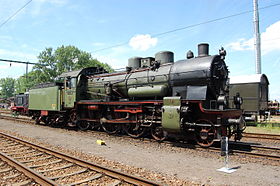Prussian P 8
| Prussian P 8 DRG Class 38.10–40 |
|
|---|---|

Prussian P 8 in state railway livery
|
|
| Quantity | ca. 3,700 |
| Year(s) of manufacture | 1908 - 1926 |
| Retired | 1974 |
| Wheel arrangement | 4-6-0 |
| Axle arrangement | 2'C h2 |
| Type | P 35.15 |
| Track gauge |
1,435 mm (4 ft 8 1⁄2 in) standard gauge 1,524 mm (5 ft) Russian Railways |
| Length over buffers | 18,585 mm (60 ft 11 3⁄4 in) |
| Service weight | 69–76.69 t (67.91–75.48 long tons; 76.06–84.54 short tons) |
| Adhesive weight | 50.60 t (49.80 long tons; 55.78 short tons) |
| Axle load | 17.36 t (17.09 long tons; 19.14 short tons) |
| Top speed | 110 km/h (68 mph) (forwards) 50 km/h (31 mph) (backwards) 85 km/h (53 mph) (backwards with tub tender) |
| Indicated Power | 868 kW (1,164 hp) |
| Driving wheel diameter | 1,750 mm (68.90 in) |
| Leading wheel diameter | 1,000 mm (39.37 in) |
| Cylinder bore | 630 mm (24.80 in) |
| Piston stroke | 691 mm (27.20 in) |
| Boiler Overpressure | 12 bar (1,200 kPa; 170 psi) |
| Grate area | 2.58 m2 (27.8 sq ft) |
| Radiative heating area | 14.58 m2 (156.9 sq ft) |
| Superheater area | 58.90 m2 (634.0 sq ft) |
| Evaporative heating area | 143.28 m2 (1,542.3 sq ft) |
| Brakes | Knorr automatic, single-chamber compressed-air brakes, working both sides of the coupled wheels, from 1913 bogie wheels also braked |
| Train heating | Steam from locomotive boiler |
The Prussian Class P 8 of the Prussian state railways (DRG Class 38.10-40 of the Deutsche Reichsbahn) was a 4-6-0 steam locomotive built from 1906 to 1923 by the Berliner Maschinenbau (previously Schwartzkopff) and twelve other German factories. The design was created by Robert Garbe. It was intended as a successor to the Prussian P 6, which was regarded as unsatisfactory.
Because Garbe was an advocate of the simplest possible designs, a straightforward, superheated steam, two-cylinder driving gear was envisaged. The P 8 benefited especially from superheated steam technology, which had just been developed by Wilhelm Schmidt (nicknamed 'hot steam Schmidt'), that led to outstanding performance for those times. The P 8 was a very economical locomotive that did not make great demands on the ability of the engine driver. At the outset Garbe even designed the P 8 as an express train locomotive, with the expectation of attaining a top speed of 110 km/h (68 mph). As a result, the first units were fitted with low-wind-resistance, tapered driver's cabs.
The enthusiasm of crews for the new locomotive was at first muted. The boiler was very effective at evaporation (there was already evidence of a combustion chamber at the front end of the firebox), however against that there were numerous teething troubles, e.g. the driving rod bearings were too small. This led continually to overheating. The loosely coupled Prussian box tender led to disturbing riding qualities when running tender-first. Its riding performance was never fully satisfactory. As a result of poor weight compensation, the top speed estimated by Garbe was never achieved and it was eventually assessed at 100 km/h (60 mph).
One characteristic feature of the P 8 is the large distance between the centre and rear coupled axles. At the outset the P 8 only had a steam dome behind the sandbox; later a forward feed dome was added. Further constructional changes affected, inter alia, the driver's cab roofs, the smoke deflectors and various external assemblies.
...
Wikipedia
